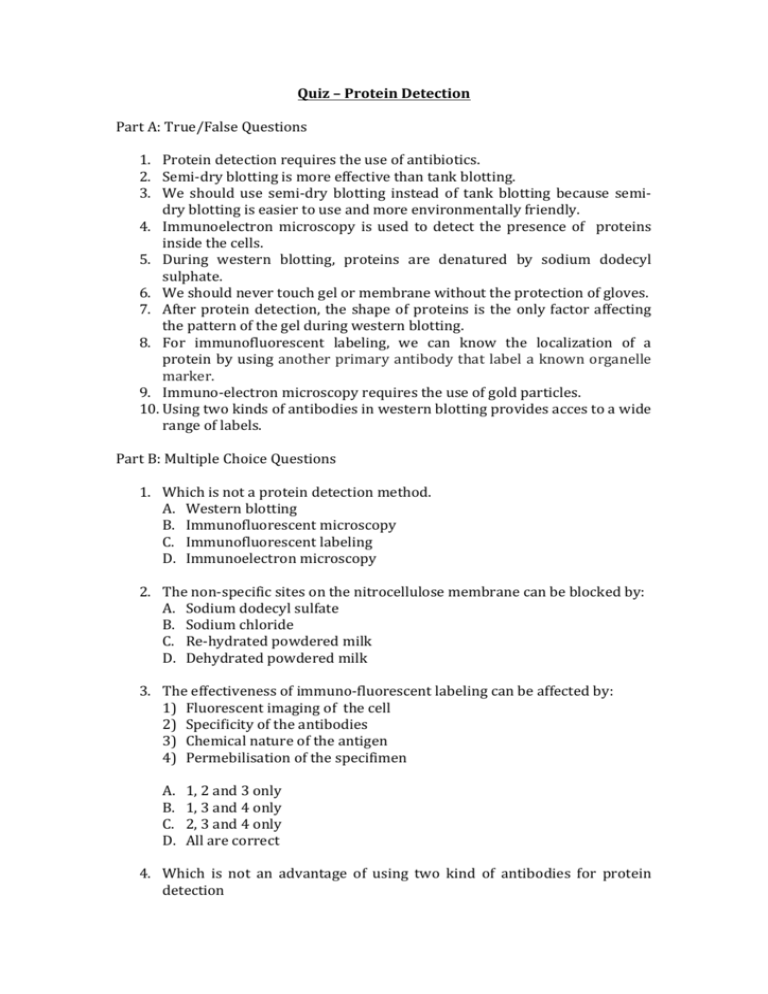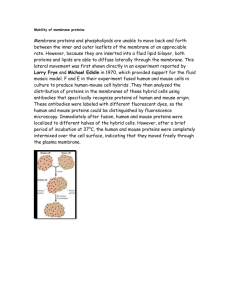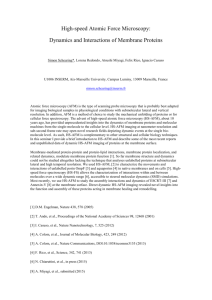Quiz – Protein Detection Part A: True/False Questions 1. Protein
advertisement

Quiz – Protein Detection Part A: True/False Questions 1. Protein detection requires the use of antibiotics. 2. Semi-­‐dry blotting is more effective than tank blotting. 3. We should use semi-­‐dry blotting instead of tank blotting because semi-­‐ dry blotting is easier to use and more environmentally friendly. 4. Immunoelectron microscopy is used to detect the presence of proteins inside the cells. 5. During western blotting, proteins are denatured by sodium dodecyl sulphate. 6. We should never touch gel or membrane without the protection of gloves. 7. After protein detection, the shape of proteins is the only factor affecting the pattern of the gel during western blotting. 8. For immunofluorescent labeling, we can know the localization of a protein by using another primary antibody that label a known organelle marker. 9. Immuno-­‐electron microscopy requires the use of gold particles. 10. Using two kinds of antibodies in western blotting provides acces to a wide range of labels. Part B: Multiple Choice Questions 1. Which is not a protein detection method. A. Western blotting B. Immunofluorescent microscopy C. Immunofluorescent labeling D. Immunoelectron microscopy 2. The non-­‐specific sites on the nitrocellulose membrane can be blocked by: A. Sodium dodecyl sulfate B. Sodium chloride C. Re-­‐hydrated powdered milk D. Dehydrated powdered milk 3. The effectiveness of immuno-­‐fluorescent labeling can be affected by: 1) Fluorescent imaging of the cell 2) Specificity of the antibodies 3) Chemical nature of the antigen 4) Permebilisation of the specifimen A. 1, 2 and 3 only B. 1, 3 and 4 only C. 2, 3 and 4 only D. All are correct 4. Which is not an advantage of using two kind of antibodies for protein detection A. Saving labeling times and expenses B. No antibodies labels are available for marking primary antibodies C. It allows us to change label type or detection methods easily for a new experiment D. It can give a stronger signal 5. Before denaturation of proteins, which of the following factors cannot affect the pattern of gel in western blotting A. Shape of the protein B. Molecular size of the protein C. The kind of secondary antiodies used during the experiment D. Charges of the protein 6. Which of the following is not a precaution for western blotting A. Adding bovine serum albumin to the nitrocellulose membrane B. Wearing gloves during the experiment C. Keeping the membrane moist D. Make sure that there is no bacteria or other microorganism in the buffer solution 7. The correct sequence for western blotting is: 1) Proteins are denatured by sodium dodecyl sulfate (SDS), and by boiling 2) Performing the polyacrylamide gel electrophoresis (PAGE) 3) Transfer proteins to the nitrocellulose membrane 4) Incubate the nitrocellulose membrane to primary antibodies and secondary antibodies subsequently A. 1,2,3,4 B. 4,1,3,2 C. 1,3,2,4 D. 1,3,2,4 8. The following procedures are belonged to which kind of protein detection methods: Fixing the cells by high-­‐pressure freezing A. Immunofluorescent microscopy B. Immunoradiating labeling C. Immunoelectron microscopy D. Immunofluorescent labeling 9. We will use gold particles during immunoelctron microscopy because gold A. Is inert B. Is shining (easier to observe) C. cheaper than platinum D. has high density 10. PAGE separates proteins according to which kind of character of proteins A. Proteins are sensitive to pH B. Different proteins have different molecular size C. Different proteins have different charges D. Proteins are sensitive to temperature








